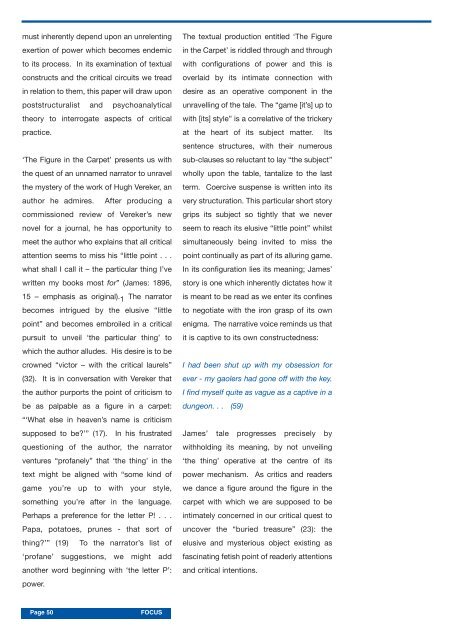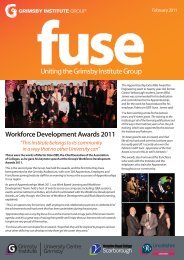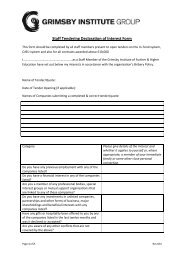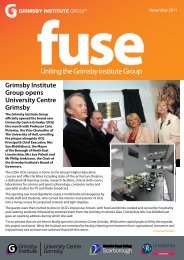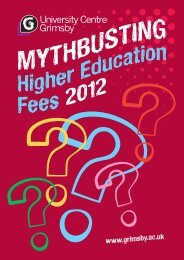Journal of Research & Scholarly Output 2006 - Grimsby Institute of ...
Journal of Research & Scholarly Output 2006 - Grimsby Institute of ...
Journal of Research & Scholarly Output 2006 - Grimsby Institute of ...
Create successful ePaper yourself
Turn your PDF publications into a flip-book with our unique Google optimized e-Paper software.
must inherently depend upon an unrelenting<br />
exertion <strong>of</strong> power which becomes endemic<br />
to its process. In its examination <strong>of</strong> textual<br />
constructs and the critical circuits we tread<br />
in relation to them, this paper will draw upon<br />
poststructuralist and psychoanalytical<br />
theory to interrogate aspects <strong>of</strong> critical<br />
practice.<br />
‘The Figure in the Carpet’ presents us with<br />
the quest <strong>of</strong> an unnamed narrator to unravel<br />
the mystery <strong>of</strong> the work <strong>of</strong> Hugh Vereker, an<br />
author he admires. After producing a<br />
commissioned review <strong>of</strong> Vereker’s new<br />
novel for a journal, he has opportunity to<br />
meet the author who explains that all critical<br />
attention seems to miss his “little point . . .<br />
what shall I call it – the particular thing I’ve<br />
written my books most for” (James: 1896,<br />
15 – emphasis as original). 1 The narrator<br />
becomes intrigued by the elusive “little<br />
point” and becomes embroiled in a critical<br />
pursuit to unveil ‘the particular thing’ to<br />
which the author alludes. His desire is to be<br />
crowned “victor – with the critical laurels”<br />
(32). It is in conversation with Vereker that<br />
the author purports the point <strong>of</strong> criticism to<br />
be as palpable as a figure in a carpet:<br />
“‘What else in heaven’s name is criticism<br />
supposed to be?’” (17). In his frustrated<br />
questioning <strong>of</strong> the author, the narrator<br />
ventures “pr<strong>of</strong>anely” that ‘the thing’ in the<br />
text might be aligned with “some kind <strong>of</strong><br />
game you’re up to with your style,<br />
something you’re after in the language.<br />
Perhaps a preference for the letter P! . . .<br />
Papa, potatoes, prunes - that sort <strong>of</strong><br />
thing?’” (19) To the narrator’s list <strong>of</strong><br />
‘pr<strong>of</strong>ane’ suggestions, we might add<br />
another word beginning with ‘the letter P’:<br />
power.<br />
The textual production entitled ‘The Figure<br />
in the Carpet’ is riddled through and through<br />
with configurations <strong>of</strong> power and this is<br />
overlaid by its intimate connection with<br />
desire as an operative component in the<br />
unravelling <strong>of</strong> the tale. The “game [it’s] up to<br />
with [its] style” is a correlative <strong>of</strong> the trickery<br />
at the heart <strong>of</strong> its subject matter. Its<br />
sentence structures, with their numerous<br />
sub-clauses so reluctant to lay “the subject”<br />
wholly upon the table, tantalize to the last<br />
term. Coercive suspense is written into its<br />
very structuration. This particular short story<br />
grips its subject so tightly that we never<br />
seem to reach its elusive “little point” whilst<br />
simultaneously being invited to miss the<br />
point continually as part <strong>of</strong> its alluring game.<br />
In its configuration lies its meaning; James’<br />
story is one which inherently dictates how it<br />
is meant to be read as we enter its confines<br />
to negotiate with the iron grasp <strong>of</strong> its own<br />
enigma. The narrative voice reminds us that<br />
it is captive to its own constructedness:<br />
I had been shut up with my obsession for<br />
ever - my gaolers had gone <strong>of</strong>f with the key.<br />
I find myself quite as vague as a captive in a<br />
dungeon. . . (59)<br />
James’ tale progresses precisely by<br />
withholding its meaning, by not unveiling<br />
‘the thing’ operative at the centre <strong>of</strong> its<br />
power mechanism. As critics and readers<br />
we dance a figure around the figure in the<br />
carpet with which we are supposed to be<br />
intimately concerned in our critical quest to<br />
uncover the “buried treasure” (23): the<br />
elusive and mysterious object existing as<br />
fascinating fetish point <strong>of</strong> readerly attentions<br />
and critical intentions.<br />
Page 50<br />
FOCUS


